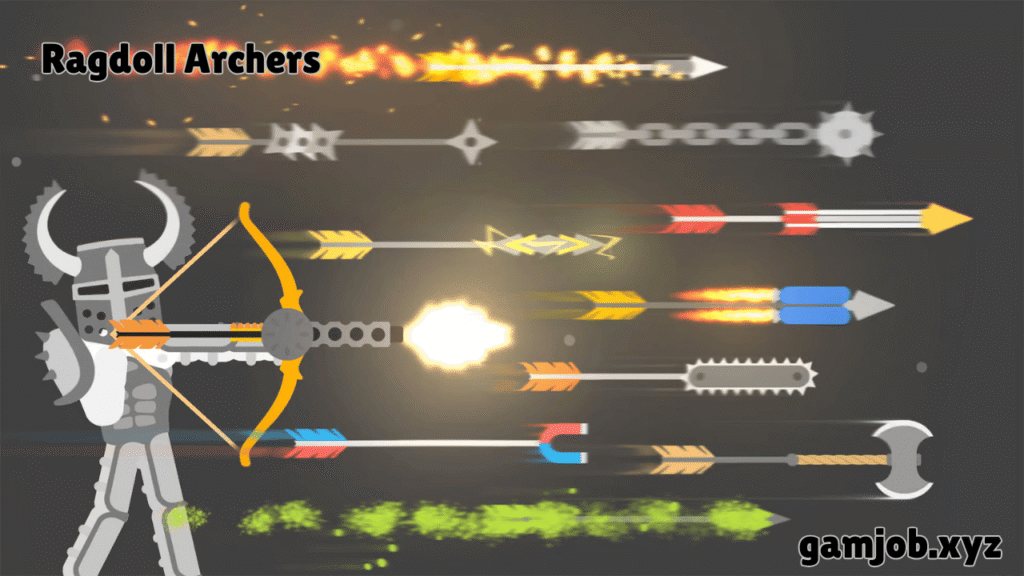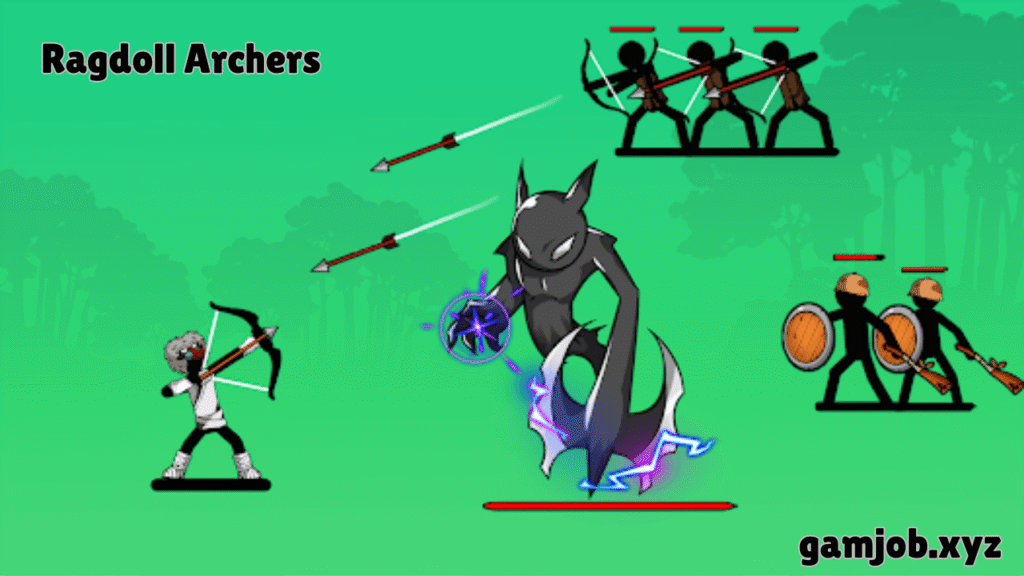Introduction
In the wild world of browser games and indie chaos, Ragdoll Archers has carved out a space where precision archery meets slapstick physics. It’s a title that, at first glance, seems like a simple aim-and-shoot challenge, but quickly blossoms into a chaotic ballet of arrows, mid-air flailing, and unpredictable movement. With every draw of the bowstring, you’re engaging in a duel that’s as much about control as it is about embracing the absurdity of ragdoll dynamics. The game stands out not just because of its combat mechanics but because of how it makes every shot, fall, or bounce feel unique—no two matches ever truly feel the same.
The premise is refreshingly simple: you control a floppy, floppy-limbed archer trying to outlast an equally unstable opponent. Yet the mastery lies in the rhythm, angle, timing, and pure madness that comes from trying to land the perfect shot while bouncing off a wall, flipping midair, or dangling by a thread of health. Over time, what begins as a casual laugh becomes a real test of reflex, prediction, and calculated madness.
The Unique Mechanics of Ragdoll Archery
At its core, Ragdoll Archers is all about momentum and reaction. You’re not moving your character like in a typical shooter or archer game; instead, the character’s body responds to every input through ragdoll physics. Want to aim up? Your archer contorts. Aim lower? He may lose balance and swing downward, causing your trajectory to shift in a way that feels hilariously frustrating and addictively unpredictable. This blend of semi-precision and full-body chaos makes every match feel like a fresh challenge.
What makes the controls stand out is how they simulate gravity and motion while retaining enough responsiveness to keep you in control. It’s not just about aiming your bow; it’s about accounting for the weight of your limbs, the tilt of your body, and even the terrain beneath your feet. When you release the arrow, it isn’t just about hitting your opponent—it’s about reading their movement, estimating where they’ll land after a fall, and adjusting on the fly.
The result is a game that’s difficult to master but endlessly rewarding. There’s something magical about getting that perfect headshot while mid-flip, both of you wobbling uncontrollably as the arrow lands with comedic finality. The ragdoll element isn’t just a gimmick—it’s the very soul of the game, turning a simple duel into a physics playground.
The Combat Experience: Skill Meets Chaos

Combat in Ragdoll Archers feels like a dance of fate. Each match begins with both players armed and ready, yet within seconds, all semblance of formality disintegrates into a blur of arrows, tumbling bodies, and groans of impact. The physics don’t just make the characters wobble—they affect how arrows fly, how players recover, and how terrain interacts with movement. This transforms typical archery gameplay into a reactive experience where your brain and instincts are constantly in motion.
Every arrow fired carries weight. If you hit your opponent’s arm, they might lose control of their aim. A leg shot could send them spinning off balance. A direct body shot? That’s more damage but also the potential for a hilarious tumble. Matches are short, intense, and often end in bursts of laughter—especially when a last-ditch arrow hits after you’ve already started celebrating.
Yet beneath the silliness lies depth. Master players understand timing, movement anticipation, and environmental awareness. They use walls to bounce arrows, predict ragdoll responses, and manipulate angles with surgical accuracy. That blend of skill and chaos is what keeps the game exciting—there’s always something new to master, a moment that makes you laugh, and an opponent waiting for a rematch.
Visual Style and Sound Design
The aesthetic of Ragdoll Archers perfectly complements its chaotic gameplay. Characters are minimalist yet expressive, with exaggerated floppy limbs and intense facial reactions that heighten every hit and fall. The environments are sparse but serve their purpose—providing platforms, obstacles, and enough visual clarity to keep the focus on movement and trajectory. Backgrounds change subtly between stages, but the real star is how well the physics are visually communicated.
Every bounce, twist, and impact is animated with flair. Arrows stick into the ground or bodies, wobbling slightly after impact. Limbs flail in ridiculous arcs when thrown by the force of a hit. These little touches sell the ragdoll effect not as an accident, but as an intentional part of the game’s identity.
Sound plays just as big a role. The twang of the bow, the soft thump of an arrow hitting a body, and the exaggerated groans or squeaks of characters help create a fully immersive (and hilarious) soundscape. There’s no bombastic orchestral soundtrack—it’s minimal, atmospheric, and perfectly tuned to amplify the absurdity of each fight. The silence between shots, broken by a single arrow’s impact, builds tension more effectively than any music cue could.
Game Modes and Replay Value
Despite its straightforward premise, Ragdoll Archers packs in impressive replayability. Whether you’re going head-to-head against AI opponents or challenging friends in local or online multiplayer, no two battles are the same. The ragdoll physics ensure unpredictable reactions every time, which makes the game endlessly replayable even without dozens of maps or weapons.
The single-player mode starts easy, letting you get used to the controls and timing. But as you progress, AI opponents become trickier, reacting faster and recovering from falls more strategically. This mode acts as both a training ground and a true challenge. You’ll find yourself returning again and again, trying to get the cleanest kill or the weirdest fluke victory.
Multiplayer, however, is where Ragdoll Archers truly shines. Facing another human, with both of you equally susceptible to the game’s unpredictability, creates moments of shared laughter, frustration, and triumph. You’ll trade epic comebacks, fluky victories, and slow-motion death shots that feel straight out of a movie.
What’s especially brilliant is that even when you lose, it’s often in such a ridiculous way that you can’t help but laugh. That emotional engagement—where wins and losses are both genuinely entertaining—is rare in games, and it’s what keeps players coming back.
Learning Curve and Skill Ceiling

For all its silliness, Ragdoll Archers has a surprising learning curve. New players may struggle at first with the floppiness, the slow draw times, or the unpredictable movement. But over time, muscle memory kicks in. You begin to anticipate the movement of your ragdoll, learn how to stabilize yourself mid-air, and time your shots with pinpoint reflexes.
The skill ceiling is high. Expert players don’t just survive longer—they manipulate the chaos. They adjust for the arc of a shot mid-fall, fake out opponents with mid-air feints, and execute kill shots while upside down or sliding across the floor. There’s finesse to be found in the madness, and those who invest time into the mechanics are rewarded with a deeper, more competitive experience.
Yet despite the depth, the game never loses its accessibility. Anyone can pick it up and have a blast. The controls are simple, the matches are quick, and the tone is always playful. That balance between casual fun and competitive mastery is a huge part of the game’s enduring appeal.
Cultural Impact and Community Love
Ragdoll Archers may not be a household name like some blockbuster titles, but in the world of indie and browser games, it’s a standout. Streamers and YouTubers frequently pick it up for its hilarious replay value and audience-friendly moments. Short-form clips of mid-air headshots or last-second saves often go viral, spreading the joy of its chaos to new players daily.
Communities around the game have sprouted up on forums, social platforms, and fan sites. Players discuss shot techniques, post funny clips, and even challenge each other to duels. What’s beautiful is how the community embraces the madness—the victories and the failures. Unlike more toxic competitive games, the tone here is light, encouraging, and celebratory.
Many fans have also started experimenting with mods and variations. Some create altered versions with different arrow types, faster physics, or larger maps. These community-driven tweaks keep the game alive and evolving, further proving its staying power as a modern classic in its genre.
Conclusion
Ragdoll Archers is more than just a funny physics-based game. It’s a brilliant combination of chaos and control, where every match tells a story, every fall is a punchline, and every perfectly timed shot feels like a cinematic triumph. Its charm lies in how it embraces imperfection—the way it makes failing fun, the way it turns basic mechanics into unpredictable entertainment, and how it transforms a simple concept into something endlessly playable.
Whether you’re looking to kill five minutes or dive into a long competitive streak, Ragdoll Archers delivers. Its visual simplicity hides a complex, rewarding system. Its silly premise hides a genuinely challenging combat mechanic. And its short matches pack more laughs and excitement than most full-length games.
In a gaming world increasingly obsessed with polish and realism, Ragdoll Archers reminds us why we fell in love with games in the first place: for the fun, the laughs, and the moments you want to tell your friends about. So pick up your bow, flop into the arena, and get ready for some of the most hilarious duels you’ll ever fight.